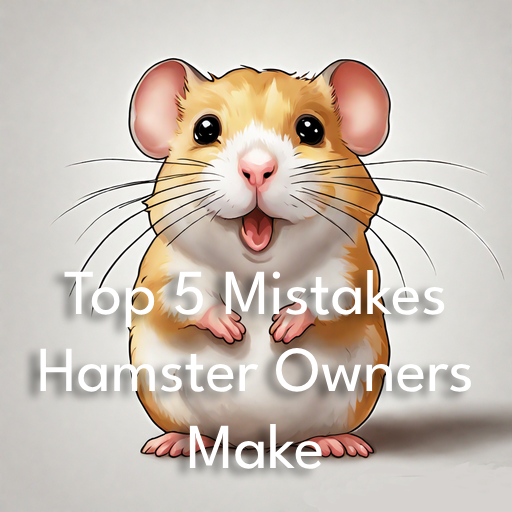You’ve got a hamster, and you’ve got a cage. Now what? It’s time to turn that enclosure into a hamster paradise. One creative way to provide it is by setting up a hamster maze. In this comprehensive guide, we’ll take you through the exciting world of hamster labyrinths, offering insights, ideas, and step-by-step instructions to create a maze that will keep your furry friend engaged and entertained.
The Importance of a Hamster Maze
Before diving into the how-tos of creating a hamster maze, it’s essential to understand why mazes are beneficial for your pet. Here are some of the key reasons:
1. Mental Stimulation:
Hamsters are intelligent animals that require mental challenges to stay happy and healthy. Mazes provide mental stimulation by encouraging problem-solving and exploration. They keep your hamster’s mind active, preventing boredom and related issues.
2. Physical Activity:
Mazes promote physical activity as your hamster navigates through tunnels, climbs ramps, and scampers through various obstacles. This exercise is crucial for maintaining your hamster’s physical well-being, preventing obesity, and ensuring they stay in shape.
3. Natural Behavior:
In the wild, hamsters spend their time burrowing and navigating intricate tunnels. A maze simulates this natural behavior and satisfies their instincts for exploration. It makes your hamster feel at home while providing a safe and controlled environment for these activities.
4. Entertainment:
Watching your hamster tackle a maze is not only enjoyable for you but also enriching for your pet. It adds a layer of entertainment to their daily routine, making life in captivity more interesting and fulfilling.
Designing Your Hamster Maze
Now that you understand the importance of a hamster maze, let’s delve into the design process. Creating a maze that’s engaging, safe, and fun for your pet requires careful planning. Here’s how to go about it:
1. Choose the Right Space:
First, designate an appropriate space within your hamster’s habitat for the maze. Ensure that the maze fits comfortably in the cage without making it too cramped. Leave enough room for other essential items like food and water bowls, a hideout, and bedding. If your cage is too small for that you can always get a playpen for your hamster which is much bigger than any cage out there. If you don’t have it yet our warm recommendation is this playpen from Amazon with many positive reviews
2. Select Materials:
Choose materials for building the maze. Hamster-safe materials include cardboard, wooden blocks, PVC pipes, and tunnels made of non-toxic plastic. Avoid materials that might have sharp edges or toxic paints, as your hamster will likely chew on the maze components.
3. Plan the Layout:
Sketch a layout for your maze on a piece of paper before assembling it. Decide on the maze’s complexity, considering your hamster’s age and experience. A simple, single-level maze may be suitable for younger hamsters, while a multi-level maze with ramps and tunnels can challenge more experienced pets.
4. Assemble the Maze:
Construct the maze according to your layout plan. Ensure that all components are securely connected and that there are no gaps or spaces where your hamster could get stuck. Keep safety in mind while creating the maze.
Hamster Maze Components and Accessories
A well-designed maze includes various components and accessories to engage your hamster fully. Here are some essential elements to consider:
1. Tunnels:
Tunnels are the heart of any hamster maze. Your pet will love scurrying through these passageways. Use cardboard tubes, PVC pipes, or store-bought hamster tunnels to create different pathways. One example of tunnels easy to assemble is this set from Amazon. The special thing is you can assemble them in any way you wish.
2. Ramps and Platforms:
Incorporate ramps and platforms to add elevation and challenge to the maze. Your hamster will enjoy climbing up and down these structures. Wooden blocks and shelves are great for creating these features.
If you lack material, you can always go with ramps from the store, such as this little climbing ladder from Amazon
3. Hideouts:
Hideouts provide your hamster with a safe space to rest and hide. You can use small wooden houses or homemade hideouts crafted from cardboard boxes. Ensure that these hideouts are well-ventilated and have multiple entrances for safety.
4. Puzzle Feeders:
Integrate puzzle feeders into the maze to stimulate your hamster’s foraging instincts. Place small treats or pieces of fresh vegetables inside these feeders, encouraging your pet to explore and work for their food.
Another example of what we mean is this cute product from Amazon
5. Toys and Obstacles:
Add toys and obstacles to make the maze more challenging and entertaining. Hamster-safe wheels, bridges, and platforms can create an engaging environment.
Safety Measures and Precautions
As you build your hamster maze, it’s crucial to prioritize your pet’s safety. Here are some safety measures and precautions to keep in mind:
1. Check for Sharp Edges:
Inspect all maze components for sharp edges or rough surfaces that could injure your hamster. Sand down any rough spots or cover them with safe materials to ensure a smooth and injury-free experience.
2. Ventilation:
Proper ventilation is essential, especially if you’re using enclosed tunnels or hideouts. Make sure there are ventilation holes or gaps to provide fresh air to your hamster.
3. Secure Components:
Ensure that all maze components are securely attached and won’t collapse or detach while your hamster is inside the maze. This prevents accidents and keeps your pet safe.
4. Supervision:
When introducing your hamster to the maze for the first time, supervise their exploration to ensure they adapt to the new environment safely. Monitor their behavior and look for signs of distress or difficulty navigating the maze.
5: Maze Maintenance and Variations
A well-maintained maze is essential for your hamster’s health and enjoyment. Regularly clean the maze components to prevent the buildup of waste or debris. Additionally, consider introducing variations to the maze to keep your hamster engaged. Change the layout, add new obstacles, or rearrange tunnels to create a sense of novelty and challenge.
DIY Hamster Maze Ideas
If you’re feeling crafty and want to create a unique maze for your hamster, here are some DIY ideas:
1. Cardboard Maze:
Craft a maze using cardboard boxes and tubes. Cut holes in the boxes to create pathways and connect them using tubes. You can easily customize the layout and create a challenging maze.
2. PVC Pipe Maze:
Use PVC pipes to build a maze with multiple tunnels and intersections. PVC pipes are durable, easy to clean, and provide endless possibilities for maze design.
3. Modular Maze:
Create a modular maze using wooden blocks and connectors. This allows you to rearrange the maze components and change the layout whenever you like.
4. Jungle Gym Maze:
Construct a multi-level maze with platforms, ramps, and hanging toys. This maze design provides your hamster with a more complex and exciting environment.
5. Secret Treasure Chest:
Scatter tiny treats around the cage, and watch your hamster become a snack-hunting detective. Hide treats in bedding, under toys, or in small containers. Your hamster’s mission: find and devour every last morsel.
6. Surprise Tunnel:
Add a surprise tunnel to a hidden area filled with treats or a comfy bed.
Your hamster will stumble upon it during their daily adventures, and it’s like discovering a hidden oasis in the desert. If you need ideas on what treats to surprise your hamster with, check out our guide 😊
Conclusion
Creating a hamster maze is an exciting and fulfilling project that benefits both you and your pet. It enriches your hamster’s life by providing mental and physical stimulation while offering you the joy of watching your furry friend navigate through the intricate passageways.
Remember to prioritize safety, cleanliness, and variety in your maze design. Whether you opt for a simple DIY maze or a more elaborate modular maze, your hamster will appreciate the effort you put into their environment. By enhancing your hamster’s habitat with a maze, you’re investing in their well-being and happiness.
As you embark on this maze-building adventure, you’ll discover the endless joy that comes from providing your hamster with a dynamic and ever-changing playground. Your pet will thank you with endless hours of exploration, exercise, and entertainment. Happy maze-making!









